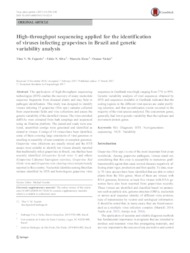High-throughput sequencing applied for the identification of viruses infecting grapevines in Brazil and genetic variability analysis.
High-throughput sequencing applied for the identification of viruses infecting grapevines in Brazil and genetic variability analysis.
Author(s): FAJARDO, T. V. M.; SILVA, F. N.; EIRAS, M.; NICKEL, O.
Summary: The application of high-throughput sequencing technologies (HTS) enables the recovery of many nucleotide sequence fragments from diseased plants and may help in pathogen identification. This study was designed to identify viruses infecting 15 grapevine (Vitis spp.) samples collected from experimental fields and vine collections and assess the genetic variability of the identified viruses. The virus-enriched dsRNAs were extracted from bark scrapings and sequenced using an Illumina platform. The paired-end reads were analyzed, assembled contigs were generated and identified as related to viruses. Contigs of 14 viruses have been identified, some of them covering large extensions of viral genomes or resulting in assembly of near-complete or complete genomes. Grapevine virus infections are usually mixed and the HTS assays were suitable to identify ten viruses already reported that traditionally infect grapevines in Brazil, one that has been recently identified (Grapevine Syrah virus 1) and others (Grapevine Cabernet Sauvignon reovirus, Grapevine Red Globe virus and Grapevine vein clearing virus) not previously reported in this country. Nucleotide identities among Brazilian isolates identified by HTS and homologous grapevine virus sequences in GenBank were high, ranging from 77% to 99%. Genetic variability analysis of viral sequences obtained by HTS and sequences available in GenBank indicated that the coding regions in the different viral species are under purifying selection, and that recombination events occurred in the majority of the viral species analyzed. The coat protein genes, generally, had lower genetic variability than the replicase and movement protein genes. Keywords Vitis . Diagnosis . HTS . Next-generation sequencing . NGS . Variability
Publication year: 2017
Types of publication: Journal article
Unit: Embrapa Grape & Wine
Keywords: Diagnosis, HTS, NGS, Next-generation sequencing, Vitis, variability
Observation
Some of Embrapa's publications are published as ePub files. To read them, use or download one of the following free software options to your computer or mobile device. Android: Google Play Books; IOS: iBooks; Windows and Linux: Calibre.
Access other publications
Access the Agricultural Research Database (BDPA) to consult Embrapa's full library collection and records.
Visit Embrapa Bookstore to purchase books and other publications sold by Embrapa.

